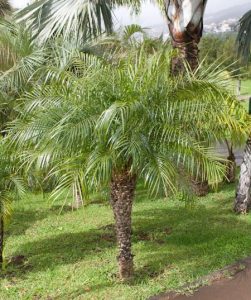Best 5 Palm Trees To Grow In Southern California
There is no doubt that the Californian palm tree is known throughout the entire world. Tourists tend to return home thinking about the beautiful palm trees they have seen when they have been on vacation.
The following is a brief pictorial article in which I give a brief overview of the palm tree species that we’ve found have done well for most of our customers in California, especially in Southern California.
Some of the species are good for sun and others are good for shade. Some are easier to grow than others, but all of them can be grown in coastal parts of Southern California, especially along the coast.
It is important to note that the species of palm trees shown below are not all those that can be grown in California. The following are just some of the species that you can grow in California.
Although, it gives the reader a brief overview of about three dozen species of succulents that he might have the opportunity of growing.
Among some of them specifically, they do best right along the seashore. The inland climate is also conducive to their growth.
Larger species as well as smaller species coexist here successfully. Some species are more tolerant of shade than others.
Here are some interesting photos that I hope you will enjoy and give you some ideas for palm trees that you wouldn’t normally see.
As you can see, I will not make any comments about each species; instead, I will provide a photo of a mature garden plant.
You can find out more about each of the species at this site by clicking on Palm Tree Care and Common Names. By clicking on that link, you will get more information about all the species below.
Mexican Fan Palm Tree

There is no better palm to choose if you are looking for a tall, mature palm that can be planted quickly than the Mexican Fan Palm.
Mexican Fan Palms can reach heights of up to 5 feet a year, transforming your garden into a tropical paradise in no time at all.
There are many species of Mexican Fan Palm, and the most common is the Washington Palm, which has upright branches with elegantly spread leaves at the ends.
In a fan-shaped silhouette with lush, light green color, the Mexican Fan Palm’s fronds can be seen from a distance catching the eye of guests and neighbors alike.
One of the best things about Mexican Fan Palms is that they are exceptionally tough, standing up to harsh conditions such as drought and harsh wind.
They can be planted simply and left to take care of themselves by means of the sunshine and rainfall. Mexican Fan Palms are really easy to maintain and you won’t have to do anything with them.
Canary Island Date Palm

Canary Island Date Palms are ranked as the number one palm planted by hotels and resorts because their tropical beauty surprises and outshines other types of palms.
A single stem canary palm variety with an attractive grey bark is distinguished by a wide trunk that grows straight upwards from the ground.
The bark of the tree is textured with a series of horizontal diamond patterns that are horizontally oriented.
A tree with a pattern resembling that of a pineapple’s skin has been nicknamed the “Pineapple Palm.” due to its similarity to fruit.
A large crown of long, arching fronds that are covered in a number of leaf blades is found at the top of each Canary Palm tree, filling the landscape with a lush, tropical look.
Until the palm’s autumn foliage turns into bright orange showy fruits, the color only becomes more intense when it is covered with large clusters of orange flowers in the spring.
The palm is tall enough to make a bold statement in your landscape even if it grows large enough to become part of it. Its vibrant colors will capture the eye of all your neighbors, and you will be able to see its vibrant colors from miles away, and it will be your invitation to escape to the tropical paradise it creates.
Dianthus Coconut Punch

Coconut Palms are known for their flavorful, large coconuts, making them one of the most popular varieties worldwide.
As an added bonus, they will grow outdoors just as well as they do in containers, so you can cultivate your own coconuts, even if you live up north.
In the warmer months of the year, you could place your Coconut Palm outside during the sunnier days, and you could bring it inside during the colder months.
Before you know it, you’ll have plenty of large coconuts with soft, creamy flesh and a rich coconut milk to enjoy.
The Coconut Palms arrive in the container growing out of a coconut. This coconut sits on top of the container creating a unique tropical look.
At some point, they will grow into a mature palm that will have a beautiful, ringed bark and a large crown carried by fronds covered with bright green leaflets.
In a container, they can grow up to about 3 to 4 feet tall, so you can place them inside your home, on a porch or patio, or anywhere that you would like.
Also, because they are tolerant of low light conditions, they will grow indoors without a problem. But no matter where you plant them, Coconut palms are tough, low-maintenance trees that have a very high heat and drought tolerance, as well as wind resistance.
Colorful Rainbow Windmill Garden Decoration

The lush foliage of the Palm tree is no longer confined to tropical regions thanks to this fresh variety of palm.
Because it is one of the most cold hardy palms currently available on the market, the Windmill Palm is a great choice for those who are looking for island-inspired good looks in colder climates.
The stunning beauty of this island plant can still be grown even in northern gardening climates, even in zone 7.
Furthermore, Windmill Palms are not only extremely cold tolerant, they’re extremely low-maintenance, and they’re naturally pest resistant, as well.
Additionally, it comes with a good look to match its effortless ease. Windmill palms are one of the tallest palm trees in the world and have fresh, fan-like fronds arranged symmetrically in a bunch in a symmetrical fashion.
On top of the trunk, this plant forms a crown of breathtaking green foliage that can grow up to ten feet wide, and can grow as high as 60 feet.
Pygmy Date Palm

This compact miniature palm will help you save space in your home or office. There are plenty of places where you can place it, from the corners of your garden, to the deck or pool.
To frame entryways on the porch, you can place it in a container and place it on the porch to frame it.
You can simply bring the palm inside once the temperature drops to a point where it gets too cold for it outside.
Having upright green branches covered with long slender leaves, the tree has a tree-like appearance.
Its limbs curve gracefully upwards at the top, creating an aesthetically pleasing crown.
Your guests and neighbors will be jealous of the beauty of the doorway as they pass by, waving hello as they pass by.
It is even possible to see small, creamy white flowers bloom from your Pygmy Date Palms in warmer climates, giving your Pygmy Date Palms a unique, eye-catching appearance.
Pindo Palm

Would you like to plant a Southern Palm in your backyard, even though you live just north of the Mason Dixon line? You might want to take a closer look at Pindo Palms.
It is a surprise to learn how hardy this date palm can be, and it can withstand the chilliest Southern winters.
Despite its sturdy build, it has been known to hold up under temperatures as low as 20°F, even in frigid weather.
There is also the fact that this is a stunning, low-growing palm that will produce an impressive amount of juicy, amber-colored fruit if you live in a warmer climate.
The reason for this is that it is a well-deserved name. The Pindo dates are so succulent and delicious that they are often used to create savory jams and jelly, which is why the Pindo tree is nicknamed the Jelly Palm. Nevertheless, the pale green leaves of the Pindo tree give it its characteristic character.
This palm tree stands out from the rest due to its prominent fronds that curve inwards and have a blue-gray sheen that enhances its distinctive appearance.
Even though it won’t be able to reach more than 25 feet in height, its leaf span can be impressive as it can reach 20 feet, and its trunk base can be as high as 2 feet.
The single trunk, a slow root growth rate, and the plant’s extreme drought tolerance, however, make it a very good candidate for container gardening.
Place them on your patio, your deck, or plant them in your yard to give a relaxing feel to your yard and create a relaxing area where you can relax.


